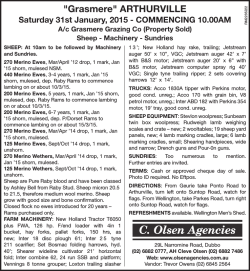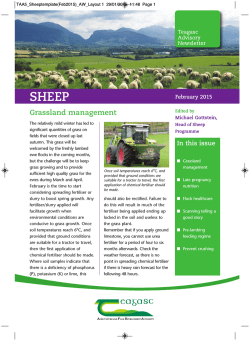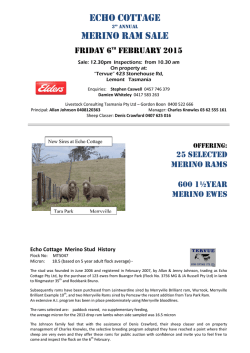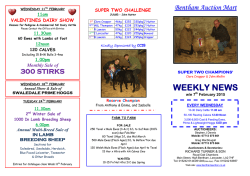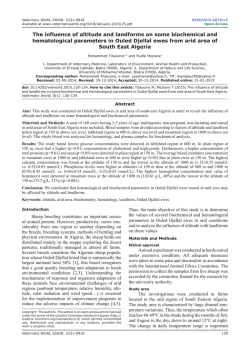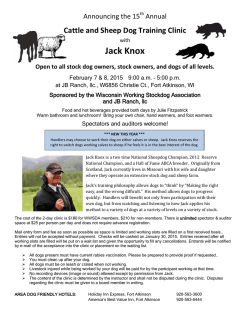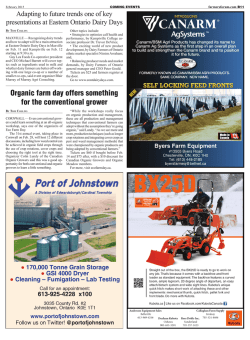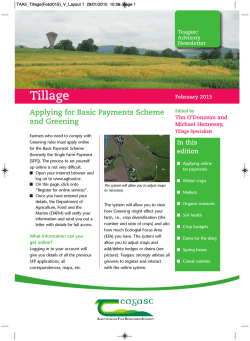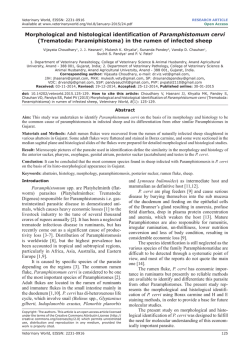
Sheep Newsletter - January 2015
TAA5_Sheeptemplate(Jan2015)_AW_Layout 1 22/12/2014 14:35 Page 1 Teagasc Advisory Newsletter SHEEP January 2015 Upcoming sheep events Edited by Shane McHugh, Sheep Specialist Teagasc is hosting three national sheep conferences in January/February of this year. These conferences are a must for sheep farmers. Hill Sheep Conference Castlecourt Hotel, Westport, Co. Mayo, Wednesday January 28, 2015 – 6.00pm Topics to be covered: n Findings from the RVL n Recording hill sheep n External parasites n Fattening hill lambs n Nutrition for hill sheep n Marketing – the Mayo story These conferences are STAP approved. National Lowland Sheep Conference 2015 Malton Hotel, Killarney, Tuesday February 3 – 3.00pm Knightsbrook Hotel, Trim, Wednesday February 4 – 3.00pm Topics to be covered: n Lambing difficulty and mortality n Vaccination and quarantine n Lameness in sheep n Making the most of grazed grass n Late pregnancy nutrition n Nutritional effects on parasite burdens Admission to conferences is free of charge courtesy of our industry sponsors, and each conference boasts an exciting panel of Irish and international speakers over two sessions. For further details, tel: 091-845200, or contact your local Teagasc office. In this issue n Important sheep conferences in early 2015 n Scan ewes in January to see which animals will need early supplementation n Don't forget ram nutrition n Update from the BETTER Farm Sheep Programme TAA5_Sheeptemplate(Jan2015)_AW_Layout 1 22/12/2014 14:35 Page 2 SHEEP Sheep census Have you completed and submitted your sheep census for 2014? Apart from there being a legal onus on you to fill in this form (if you have sheep), it is also essential to enable you to make a claim under the Grassland Sheep Scheme. This year there is also a requirement to identify the number of sheep that belong to mountain and mountain crossbreeds. The form must be submitted to the Department of Agriculture by Friday January 31, 2015. It is a good idea to keep a copy of the census for your own records, and to register the letter when posting it. Farmers have the option of completing the census online at www.agriculture.gov.ie and selecting the option for ‘Online Services’. If you have any queries regarding the form, there is a lo-call helpline available. For queries regarding completion of the sheep/goat census form, please contact 076106 4426. Scanning January is the peak time for scanning March lambing flocks. Scanning is an essential tool in managing your ewe flock pre lambing. Aim to scan the ewes 80 days after ram turnout, but in order for all pregnant sheep to be identifiable the rams must have been removed at least 40 days prior to scanning. The benefit of scanning ewes is to be able to identify those that are carrying twins and triplets. Triplet-bearing ewes will need supplementary feed much earlier than twin- or single-bearing ewes, so identifying these 10 weeks out from lambing is critical if their dietary requirements are to be met. With moderate quality grass silage (66% DMD), triplet-bearing ewes should start receiving 0.2kg concentrates 10 weeks out from lambing. With good quality silage, meal feeding can be delayed by two weeks. Condition of ewe flock At scanning time condition of the ewes should be assessed. Any thinner ewes should be removed and treated as a separate group until their condition has improved. These thinner ewes are the first ewes to cause problems around lambing, such as small weak lambs, or lack of milk to rear Triplet-bearing ewes will need supplementary feeding much earlier than twin- or single-bearing ewes. lambs. Additional attention to these ewes at this stage will pay off during a busy lambing time. Ram nutrition Rams are often forgotten about after the mating season on sheep farms. However, the two to three months after the ram is removed from the ewe flock is crucial for the ram to replace lost weight and body condition. This is especially important in ram lambs and hogget rams as these animals are still growing and developing. Aim to feed 0.5-0.8kg of concentrate per day with good quality forage. TAA5_Sheeptemplate(Jan2015)_AW_Layout 1 22/12/2014 14:35 Page 3 JANUARY 2015 BETTER FARM UPDATE Time to scan and analyse feed requirements By Ciaran Lynch, Animal and Grassland Research and Innovation Centre, Athenry, Co. Galway. Scanning The first scan results from the mid-season flocks look promising. The rest of the flocks in the programme will complete this task from late December into early January depending on ram turnout date. In most of the cases where ewe lambs were mated these will be scanned later on. Winter feeding In all cases grass silage forms the basis of the diet during the housing period on these farms. Through their local advisers, each of the farmers has completed their respective forage analysis this month. On average the silage quality improved slightly – see Table 1. Table 1. Silage quality for the 2014 season. Mean Range DM (%) 33.3 (16.6-64.6) PH 4.8 (4.5-5.0) NH3 (% total N) 12.0 (5-20) Protein (% DM) 12.8 (9.3-16.2) ME (Mj/kg DM) 10.9 (9.9-11.4) DMD (% DM) 71.2 (68-74) However, this was a reflection of fewer farmers producing poor quality silage as opposed to producing top quality silage. This is still an area that needs be addressed on a number of farms as it has a large bearing on the amount of concentrate supplementation needed during late pregnancy. These results will determine how much supplementation is needed for each farm. Following scanning, a feeding regime will be drawn up for each flock to meet the ewes’ demands in late pregnancy. E-Profit monitor One of the first tasks for the New Year is to reflect on the farm’s performance during the previous 12 months. The farmers in the programme, with their advisers, will complete their E-profit monitor for 2014. For each farm the strengths and weaknesses of the systems will be examined and this helps to identify areas where improvement is needed. New flocks We are pleased to announce, in a further expansion of the programme, that three new flocks were recruited into the BETTER Farm Sheep Programme in early December. Details of these farms are summarised in Table 2. Table 2: New flocks in the BETTER Farm Sheep Programme. Farmer Location System Patrick Dunne Glenmalure, Co. Wicklow Hill flock Dennis O’Riordan Bantry, Co. Cork Hill flock Michael and John Prendergast Hollymount Co. Mayo Lowland flock Adviser Declan Byrne Michael Connolly Eamonn Patten TAA5_Sheeptemplate(Jan2015)_AW_Layout 1 22/12/2014 14:35 Page 4 SHEEP RESEARCH UPDATE Feed decisions for winter Philip Creighton, Sheep Research Demonstration Farm, Animal and Grassland Research and Innovation Centre, Teagasc Athenry, Co Galway. The first of the ewes have been housed, with both high stocking rate (14 ewes/ha) groups housed in early December and both medium stocking rate groups housed in mid December. Silage quality analysis shows silages varying in quality between 67% and 73% DMD. Housed ewes are currently being fed a maintenance diet of the 67% DMD baled silage, with the higher quality 73% DMD being kept to be fed in the later stages of pregnancy, which will reduce the quantities of meal required. Weather permitting the low stocking rate groups have sufficient reserves to support extended grazing until mid January. Groups are being strip grazed using temporary electric fencing. Grass growth on the paddocks that have been closed since late October/early November has been good but this grass will be of more benefit next March than if grazed now. Total grass grown for the year has ranged between 11t DM/ha (low stocking rate) to 12.5t DM/ha (high stocking rate). Ewes will be scanned in early January. Lamb drafting is almost complete with 97%, 94% and 90% of lambs in the low, medium, and high SR groups, respectively, drafted up to mid December. Lambs have been on silage (73% DMD) and meal (0.7kg/hd/day) since late November. For further information on any issues raised in this newsletter, or to access other enterprise newsletters, please contact your local Teagasc adviser or see www.teagasc.ie. Produced by Think Media. Housed ewes are currently being fed a maintenance diet of 67% DMD baled silage.
© Copyright 2024
